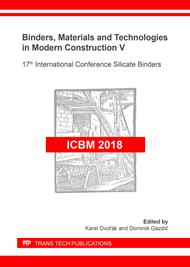[1]
J. VIDLÁŘ, J., Z. RŮŽIČKOVÁ, J. SRB Treatment of secondary raw materials. Ostrava: Vysoká škola báňská (1985).
Google Scholar
[2]
M. KALOČ, L. BROŽ, J. KRET Iron metallurgy I. Ostrava: Vysoká škola báňská (1986).
Google Scholar
[3]
L. BROŽ Production of pig iron. Ostrava: Vysoká škola báňská (1964).
Google Scholar
[4]
F. KRESTA Secondary raw materials in road construction. Ostrava: VŠB-TU Ostrava (2012).
Google Scholar
[5]
Z. ČÍŽEK Metallurgical slag - a specific type of waste Plzeň: Analytická laboratoř Plzeň s.r.o. (2009).
Google Scholar
[6]
J. VLČEK Material utilization of slags from iron and steel metallurgy by alkaline activation method. Habilitation work Ostrava: MS FMMI VŠB-TUO (2008).
Google Scholar
[7]
TP 138 Use of slag aggregate in roads. Brno: Technical University, Faculty of Civil Engineering (2011).
Google Scholar
[8]
ČSN EN 1097-2, 2010. Tests for mechanical and physical properties of aggregates – Part 2: Methods for the determination of resistance to fragmentation. Praha: Český normalizační institut (1999).
Google Scholar
[9]
ČSN EN 1097-7 Testing of the mechanical and physical properties of aggregates - Part 7: Determination of the specific gravity of the filler - Pycnometric test. Praha: Český normalizační institut (2008).
Google Scholar
[10]
ČSN EN 1097-6 Tests for mechanical and physical properties of aggregates - Part 6: Determination of particle density and water absorption. Praha: Český normalizační institut (2014).
Google Scholar
[11]
ČSN EN 1367-1, 2007. Zkoušení odolnosti kameniva vůči teplotě a zvětrávání – Část 1: Stanovení odolnosti proti zmrazování a rozmrazování. Praha: Český normalizační institut.
Google Scholar
[12]
V. S. RAMACHANDRAN Handbook of Thermal Analysis of Construction Materials. Norwich: Noyes Publications/William Andrew Publishing, (2003).
Google Scholar
[13]
R. KOPLÍK Methods of atomic spectrometry. Ústav analýzy potravin a výživy, Praha.
Google Scholar
[14]
ČSN EN 1744-6 Tests for chemical properties of aggregates - Part 6: Determination of the influence of recycled aggregate extract on the initial setting time of cement, Český normalizační institut (2006).
DOI: 10.3403/30088153
Google Scholar
[15]
L. Procházka Possibilities of using slag aggregate from the Koněv heap, Ostrava: VŠB-TUO (2017).
Google Scholar
[16]
ČSN EN 206-1 Concrete - Part 1: Specifications, properties, production and conformity (2013).
Google Scholar
[17]
TP 138, The use of slag aggregates in roads, Brno University of Technology, Faculty of Civil Engineering (2000).
Google Scholar
[18]
Pešata M. Determination of basic physical-mechanical properties of slag aggregate, Ostrava: VŠB-TUO (2016).
Google Scholar


